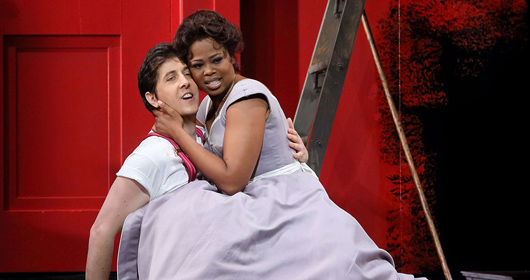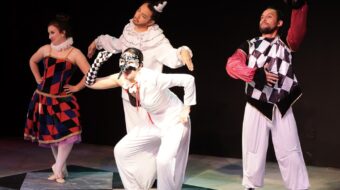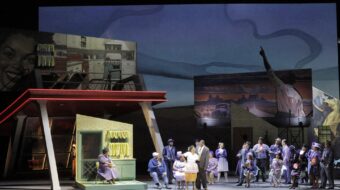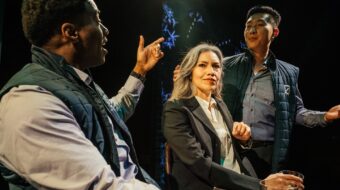
The overture to Wolfgang Amadeus Mozart’s 1786 masterpiece The Marriage of Figaro (Le Nozze di Figaro) is among the most popular in opera, while the glorious music overall is among the best in the entire operatic and classical canon. Wearing an open black shirt and his white hair flying, maestro James Conlon went all Lenny Bernstein exuberantly conducting Marriage with flair, from first to final note. (The last time LA Opera presented Marriage its General Director, Placido Domingo, conducted.)
It’s interesting to see Marriage in this season of Figaro-themed productions based on Pierre Augustin Beaumarchais’ original 18th-century plays, onstage at not only the Dorothy Chandler Pavilion but at A Noise Within’s theater. I had just seen the latter’s rather freewheeling version of Figaro, which is basically the same story as Marriage sans Mozart’s sublime score, so this made it easier for me to follow the action. In any case, follow the proverbial bouncing ball in Marriage‘s plot via Beaumarchais and opera librettist Lorenzo da Ponte.
As the lascivious, devious Count Almaviva’s (bass-baritone Ryan McKinny) servants, Figaro (Italian bass-baritone Roberto Tagliavini) and Susanna (South African soprano Pretty Yende), prepare for their nuptials the newlyweds-to-be must contend with aristocracy’s despicable droit du seigneur. This ancient feudal law allowed the lord to deflower proletarian brides before they consummated their weddings with their commoner husbands. So the ever resourceful Figaro and Susanna must scheme to thwart their “master’s” marital rape of the bewitching bride-to-be.
At the same time, the aristocrat’s scorned, forlorn wife, Countess Almaviva (Chinese soprano Guanqun Yu), seeks to rein in her adulterous husband’s serial philandering and to be reunited with him. (As depicted in Rossini’s 1816 The Barber of Seville, which LA Opera presented earlier this season, the fickle Count Almaviva had ardently pursued Rosina to make her his Countess, but years later, when Marriage takes place, he has become bored by his now downcast wife.)
The plot thickens: The randy cross-dressing male Cherubino (mezzo-soprano Renee Rapier), his adolescent hormones raging out of control, lusts for Rosina, Susanna and Barbarina (portrayed at the premiere by South Korean soprano So Young Park and on April 9 & 12 by soprano Vanessa Becerra). Cherubino, who dresses up in women’s clothing, becomes a soldier who’d prefer by far to make love, not war. Further complicating matters, Marcellina (mezzo-soprano Lucy Schaufer) has her own designs on Figaro, and it is one of the opera’s biggest surprises when we find out why she really loves Figaro. Icelandic bass Kristinn Sigmundsson, who recently played Don Basilio (depicted here by tenor Robert Brubaker) in Barber, portrays Marriage‘s Doctor Bartolo with the same comic panache he displayed in Barber.
In other words, this opera is mostly about sex. Although the Count and lowly servant have a war of wits, pitting the patrician against the plebeian, Mozart mostly plays this class struggle for laughs. There are also lots of war-between-the-sexes jokes and jibes.
As the issue of diversity and show biz has been much in the news of late, it’s worth noting that what’s called “non-traditional casting” actually enhances this production. The aptly named Pretty Yende is Black, which adds another layer to the complexity, wherein the aristo seeks to assert his reprehensible droit du seigneur. The casting of an African woman as Susanna is redolent and reminiscent of generations of slave masters who coerced their female “chattel” to have sex with them at Southern plantations. The casting of Ms. Yu as the Countess may be a reference to how some Westerners view Asian women as “trophy” wives and/or lovers (although Yu’s Rosina is no stereotypical lotus blossom).
The casting of these talented non-white women in roles portrayed since the 18th century by mostly European performers demonstrates what “affirmative action” really is in action: Opening up the doors so that individuals possessing the gifts they are endowed with can use them to their fullest expression. And in doing so, enrich the overall theatergoing experience, while providing work to deserving artists and others: From each according to their abilities, to each according to their needs.
Ms. Yu’s rendition of the Countess’ arias “Porgi amor” (“Love, thou holy purest impulse”) and “Dovo sono” (“They are over”) are as lovely as anyone could ask for. We are all the better for it when inclusion, rather than exclusion, is the watchword of the day, on- and offstage.
This is also true for the transgender role playing. Ms. Rapier’s rendition of the (purportedly) male Cherubino’s aria “Voi che sapete” (“What is this feeling?”) about adolescent love is utterly beguiling and charming. Sigmundsson’s mock malevolent interpretation of the aria “La vendetta, oh, la vendetta” (“Revenge, oh, sweet revenge”) is likewise top notch.
As when LA Opera last presented The Marriage of Figaro about five years ago, Ian Judge again deftly directs the players, but scenery designer Tim Goodchild’s humdrum sets still only come alive in the gorgeous garden scene, with its full moon – although I don’t quite understand how chandeliers could be suspended outdoors. And once again this production also unnecessarily inserts modern references, such as telephones and flashlights, into the 18th-century milieu, which only serve to distract from what is otherwise a period piece. These intrusions do not enhance the work but are only 20th-century distractions that really don’t belong here. But these are mere quibbles. The choreography by Sergio Trujillo and Chad Everett Allen, plus chorus directed by Grant Gershon, however, are all grand.
The production clocked in at 3.5 hours-plus. For that period of time one is transported from Earth to Planet Mozart. Wolfgang’s vision of love reigning supreme is sublime splendor, with music to match.
The Marriage of Figaro is being performed Saturday April 4 and Thursday April 9 at 7:30 pm and Sunday April 12 at 2:00 pm at LA Opera at the Dorothy Chandler Pavilion, 135 N. Grand Ave. For more info: (213) 972-8001; www.laopera.com.
(On a sorrowful note: LA Opera lost one of its own, Kazakhstan bass-baritone Oleg Bryjak, who perished in that Germanwings jet crash in the French Alps. He had performed at least twice at the Dorothy Chandler, including in Beethoven’s Fidelio. Aloha oe: Farewell to thee, Oleg.)
Photo: LA Opera

MOST POPULAR TODAY

Zionist organizations leading campaign to stop ceasefire resolutions in D.C. area

High Court essentially bans demonstrations, freedom of assembly in Deep South

U.S. imperialism’s ‘ironclad’ support for Israel increases fascist danger at home


UN warns that Israel is still blocking humanitarian aid to Gaza






Comments